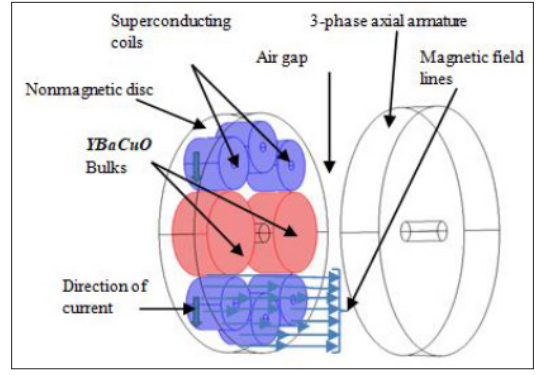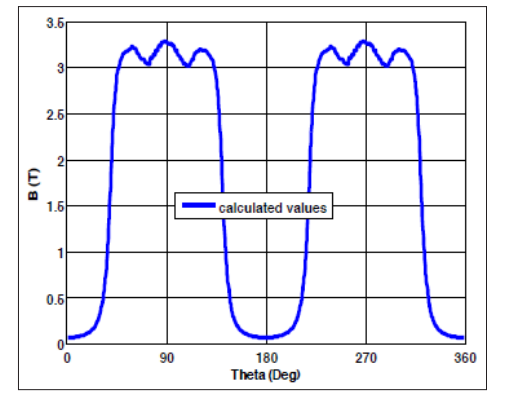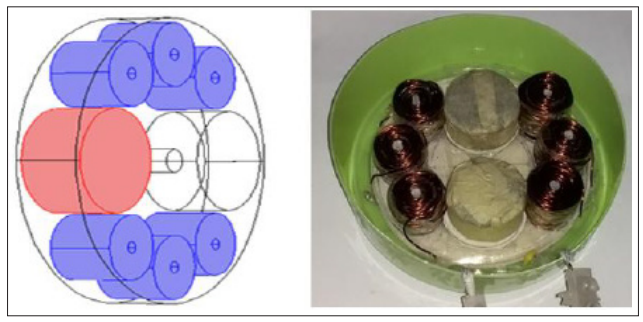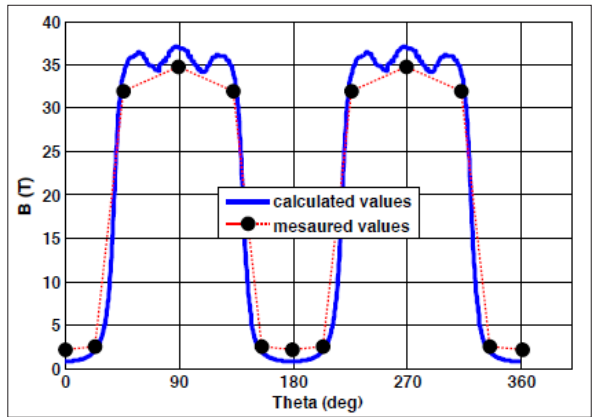Study of a New Axial-Field Superconductor Inductor for a Synchronous Machine
© 2024 Hakim Douar, Larbi Hadjout, Ailam El Hadj, et al. This is an open-access article distributed under the terms of the Creative Commons Attribution License, which permits unrestricted use, distribution, and reproduction in any medium, provided the original author and source are credited.
Abstract
In this work, a new topology of an inductor of axial flux synchronous machine is presented and tested. It is executed by combining superconducting (SC) bulks and six solenoids. It consists of six superconducting solenoids connected in series stuck in a non-magnetic disc and supplied by direct current. The presence of two SC bulks which by their magnetic field screening property, modulate and redirect the flux density lines produced by the six solenoids. Thus, we can generate a periodic spatial variation of the axial flux density component.
A 3D Electromagnetic modeling based on finite elements solution is developed to demonstrate the suitability of using the magnetic shielding properties of the SC bulks. In order to check the screening properties of the SC bulk, a prototype of the proposed inductor has been constructed at the laboratory. it consists of six copper solenoids and two circular shape superconducting YBCO bulks.
Introduction
The advances in the technology of superconducting materials and cryogenic systems are at the origin of a new generation of electric actuators. Indeed, the use of superconductors allows to generate very intense magnetic fields and to transmit energy without losses [1].
One of the main challenges to use of superconductors in electrical machines is increasing the flux density in the air gap and therefore reduces the volume of the electrical machine [2].
Various topologies of synchronous machines have been realized with inductors excited by superconductor coils. In synchronous machines with axial flux, the magnetic field is directed along the axis with "flower petal" windings. Several structures have been realized, distinguishing three categories, machines with superconducting coils, others with passive superconducting materials (bulks) and machines with both types of the materials [1,3]. In this work, a new topology of an inductor of an axial- field synchronous machine is presented and constructed in the laboratory. It is executed by combining SC bulks and solenoid. This inductor, as shown in Figure 1, is made up of six superconducting solenoids connected in series stuck in a non-magnetic disc supplied by direct current. The presence of two SC bulks which by their magnetic field screening property, modulate and redirect the flux density lines produced by the solenoids [3,4]. Thus, we can generate a periodic spatial variation of the axial flux density component. In fact, each HTC superconducting bulks placed on the non-magnetic disk (inductor) cooled with liquid nitrogen constitutes a barrier against the passage of the flux density lines created by the superconducting solenoids [5,6].

Figure 1: Topology of the Axial Field Concentration Machine
Electromagnetic Modeling
In order to study the feasibility of this new topology inductor of synchronous machine, a 3D Electromagnetic modeling based on finite elements solution is developed. The model was solved in magneto-static without induced currents. Using a magnetic vector potential formulation, noted A, the flux density B is defined by:

It is considered in this modeling that the superconducting solenoids is supplied by a uniform current density across their sections area and low relative permeability μ = 10−4 of the SC bulk to take into account its screening property. The magnetic potential is taken as zero on the surfaces of a box encompassing the structure of the inductor and the armature.
The developed 3D elements finite model is simulated for the proposed inductor with superconducting solenoids supplied by DC current with a density of 743.17 A/mm2.
It can be seen in Figure 2 that the axial flux density component predicted by the 3D developed model has a periodic spatial variation and its amplitude varies between positive Bmin and Bmax values. The maximum value reaches 3.3T.
In Figure 3, we can clearly see the screening effect of the two SC bulks.

Figure 2: Axial Flux Density Waveform in the Air Gap

Figure 3: Flux Density Distribution in the Air Gap
Expérimental Results
A prototype of the proposed inductor has been constructed in the laboratory. As shown in Figure 4, it consists of six solenoids connected in series with the copper and two circular shape superconducting bulks. The SC bulk is made from YBCO material. The critical temperature of this superconductor is 93K. This inductor is cooled with liquid nitrogen to 77K.The test is carried out by supplying the solenoid with DC current of I=8.45 A. It can be seen in Figure 5 that the flux density waveform predicted by the 3D developed model is in a good agreement compared to the experiments. The maximum of flux density measured in the air gap reaches 36.8 mT.
Conclusion
A new topology of an inductor of axial flux synchronous machine is presented in this work. It consists of six superconducting solenoids supplied by direct current and two superconducting bulks which by their magnetic field screening property, allows to generate a periodic spatial variation of the axial flux density component.
A prototype of the proposed inductor consisting of six copper solenoids and two superconducting YBCO bulks has been developed and constructed in the laboratory.
The results obtained by 3D FE and experiments are in good agreement and they show the feasibility of the new topology of the proposed inductor. Thus, with superconducting solenoid it is possible to considerably increase the flux density in the air gap and therefore reduce the volume of the electrical machine.

Figure 4: Realized Prototype of New Inductor

Figure 5: Flux Density Comparison between Experimental and 3D FE
References
- Ailam EH, Benallal MN, Hachama M, Leveque J, Rezzoug A (2013) Comparison Study Between Several Solutions of Superconducting Inductors. IEEE Transactions on Applied Superconductivity 23: 5200506-5200506.
- Goddard KF, Lukasik B, Sykulski JK (2009) Alternative Designs of High-Temperature Superconducting Synchronous Generators. IEEE Transactions on Applied Superconductivity 19: 3805-3811.
- Masson PJ, Luongo CA (2005) High Power Density Superconducting Motor for All-Electric Aircraft Propulsion. IEEE Transactions on Applied Superconductivity 15: 2226-
- Netter D, Leveque J, Ailam E, Douine B, Rezzoug A, et al. (2005) Theoretical study of a new kind HTS motor. IEEE Transactions on Applied Superconductivity 15: 2186-2189.
- Alhasan R, Lubin T, Leveque J (2014) Study and test of a new superconducting inductor structure for a synchronous International Conference on Electrical Sciences and Technologies in Maghreb (CISTEM) Tunis 1-7.
- Kelouaz M, Ouazir Y, Hadjout L (2018) 3D Magnetic field modeling of a new synchronous machine using network method reluctance. Physica C: Superconductivity and its Applications 548: 5-13.

